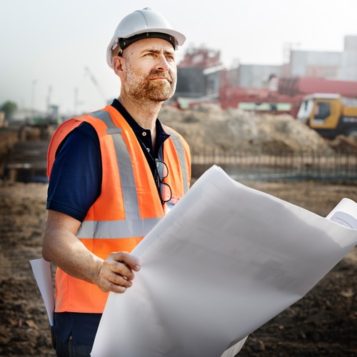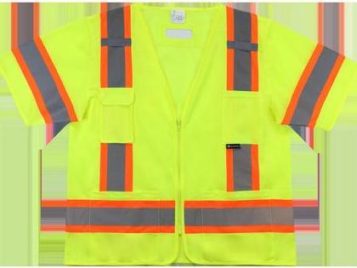
By Greg Plunkett
Most construction superintendents know that high-visibility gear is critical to worker safety, especially for those working around moving vehicles and equipment on jobsites. But there are so many different options – with different color-ways, different reflective tape patterns and different sleeve lengths – how do you choose the right hi-viz apparel for the job?
The first thing to understand is there’s a federal mandate that requires select workers to wear high-visibility apparel. The Manual on Uniform Traffic Control Devices 2009 (MUTCD 2009), which is translated and enforced by each state and has been interpreted by the Occupation Safety and Health Administration, requires employees that work on highway and road construction work zones to wear high-visibility garments when they work as flaggers, or when exposed to public vehicle traffic and/or construction equipment.
Other classes of occupational workers, such as commercial construction pros, are not required to wear high-visibility safety apparel by federal law. However, the American National Standards Institute has established high-visibility standards, to help employers and managers across occupations such as building and construction, choose high-visibility clothing that is appropriate for the safety of their workers.
The ANSI/ISEA 107-2015 standard sets forth what qualifies as an approved fluorescent material and reflective tape, as well as what level of brightness and coverage are required for various kinds of work environments. ANSI 107 establishes four performance classes (Class 1, Class 2, Class 3 and Class E) and three garment types (Type O, Type R and Type P).
Performance Class 1 offers the minimum amount of high-visibility materials needed to differentiate the wearer from non-complex work environments, such as in warehouses. On the other side of the spectrum is Class 3, which offers the greatest amount of high-visibility materials to allow for the best definition of the human form in both complex backgrounds and through a full range of movement. Class 3 performance clothing is typically worn by road or maintenance workers in highway work zones. Class 2 garments fall between the other two in the amount of background and retro-reflective materials.
Class E describes pants or bibs that do not meet the requirements of any performance class by themselves. But, when worn with Class 2 or Class 3 vests, shirts, etc., the total ensemble of pants/bibs and tops is classified as Class 3.
In addition to the performance classes, the ANSI standard also establishes three garment types: Type O for work that takes place off-road or in controlled environments, Type R intended for roadways and Type P for public safety workers. Performance class and garment type are co-dependent, which means that to qualify under the ANSI standard, the apparel must have both a class and a type (not just one or the other).
Special considerations for construction managers
Construction industry personnel who do not work in environments with moving equipment might only need Class 1, Type O high-visibility apparel. This is the minimum requirement. However, it might make sense, based on the specific lighting or traffic conditions within a work zone, to consider a higher performance class of garment. Certainly, nothing prohibits this.
Choosing the right high-visibility clothing for the job per the ANSI standard is a good first step to preventing injuries on a worksite. But workers must use the garments and care for them. To cater to user preferences and improve the likelihood that garments get worn, construction superintendents may want to consider some of the following features:
- Surveyor-specific styles with mic tabs, double pockets for storage, pen slot pockets, etc.
- D-rings for connectivity to fall protection harnesses
- Breakaway vests for those working around machinery
- Wicking material to improve dryness against the skin
- Mesh for breathability
- Wider neck openings on shirts for comfort and breathability
- Drawstrings or adjustable straps at the waist for a custom fit
- Fitted styles for women or smaller body shapes
- Breaks in reflective tape at side seams to allow for extra stretch
Side note: safety stats
- BLS reported 5,190 workplace fatalities in 2016
- Highest number of fatalities by industry:
- Construction: 991
- Transportation and warehousing: 825
- Agriculture, forestry, fishing and hunting: 593
- Professional and business services: 540
- Manufacturing: 318
- In 2015 there were an estimated 96,626 crashes in work zones, an increase of 7.8% over 2014
- In 2014, there were 119 roadway construction worker fatalities
- Workplace fatalities that occur at a road construction site typically account for 1.5-3 percent of all workplace fatalities annually (33 percent)
- More workers are struck and killed by construction equipment (38 percent) than by cars, vans and tractor-trailers (33 percent)
For more info, visit: Bureau of Labor Statistics or Occupational Safety and Health Administration.
Greg Plunkett is senior director of marketing for West Chester Protective Gear. He can be reached at 1-800-647-1900 or gplunkett@westchestergear.com.






 Join our thriving community of 70,000+ superintendents and trade professionals on LinkedIn!
Join our thriving community of 70,000+ superintendents and trade professionals on LinkedIn! Search our job board for your next opportunity, or post an opening within your company.
Search our job board for your next opportunity, or post an opening within your company. Subscribe to our monthly
Construction Superintendent eNewsletter and stay current.
Subscribe to our monthly
Construction Superintendent eNewsletter and stay current.